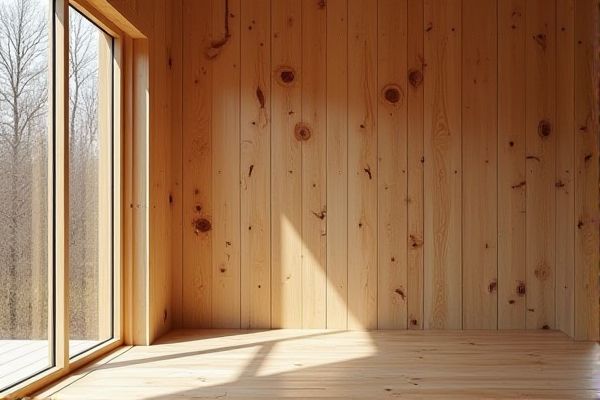
Rough sawn wood offers a natural, textured surface ideal for rustic projects, while smooth finish wood provides a polished look better suited for furniture and detailed carpentry. Explore the rest of this article to discover which wood finish best fits Your woodworking needs.
Table of Comparison
| Feature | Rough Sawn Wood | Smooth Finish Wood |
|---|---|---|
| Surface Texture | Coarse, uneven, natural grain visible | Even, polished, smooth to touch |
| Appearance | Rustic and natural | Refined and elegant |
| Preparation | Minimal processing, cut directly from the log | Planed, sanded, and sometimes sealed or finished |
| Cost | Typically lower due to less processing | Higher due to additional finishing steps |
| Applications | Construction, framing, rustic furniture, outdoor use | Interior furniture, cabinetry, flooring, decorative projects |
| Durability | Durable but may require more maintenance | Durable with better protection against wear |
| Moisture Resistance | More porous, absorbs moisture easily | Less porous due to finishing, better moisture resistance |
Introduction to Rough Sawn and Smooth Finish Wood
Rough sawn wood features a coarse texture created by cutting timber with a band or circular saw, leaving visible saw marks and a naturally rustic appearance ideal for outdoor projects and structural uses. Smooth finish wood undergoes additional planning and sanding processes, resulting in a sleek, polished surface preferred for furniture, cabinetry, and interior trim where aesthetics and tactile smoothness are crucial. The choice between rough sawn and smooth finish wood depends on project requirements for texture, durability, and visual appeal.
Defining Rough Sawn Wood
Rough sawn wood is lumber that is cut directly from the log with a rough, textured surface, preserving its natural, unplaned state. This type of wood retains saw marks and a coarse finish, making it ideal for rustic furniture, outdoor projects, and applications requiring enhanced grip or unique aesthetics. Unlike smooth finish wood, rough sawn wood provides superior traction and a more organic appearance, often preferred in construction and landscaping.
Characteristics of Smooth Finish Wood
Smooth finish wood features a finely sanded surface that highlights the natural grain and texture, enhancing aesthetic appeal for furniture and interior applications. This type of wood undergoes additional processing like planing and sanding, resulting in a sleek, uniform finish that is easier to paint, stain, or seal. Its smooth texture also reduces splinters, making it safer and more comfortable for direct contact in construction and carpentry projects.
Visual Appeal: Texture and Grain Differences
Rough sawn wood showcases a natural, rustic texture with pronounced grain patterns that emphasize organic imperfections and add character to surfaces. Smooth finish wood highlights refined grain details through sanding and polishing, creating a sleek, uniform appearance ideal for modern and polished designs. The choice between rough sawn and smooth finish wood significantly influences interior aesthetics, balancing raw, tactile visuals against elegant, clean lines.
Common Applications for Each Wood Type
Rough sawn wood is commonly used in construction projects, fencing, and rustic furniture where a natural, textured appearance and better grip are desired. Smooth finish wood is ideal for interior applications such as cabinetry, flooring, and decorative trim where a polished, refined surface enhances aesthetics and ease of cleaning. Your choice depends on whether durability and rustic charm or sleek appearance and comfort are priorities for your project.
Durability and Wear Over Time
Rough sawn wood exhibits increased durability due to its thicker, less processed surface, which naturally resists wear and damage better over time. Smooth finish wood, while visually appealing and easier to clean, tends to show scratches, dents, and signs of wear more prominently because of its polished surface. Choosing rough sawn wood is ideal for high-traffic or outdoor applications where longevity and resistance to physical impact are critical.
Cost Comparison: Rough vs Smooth Wood
Rough sawn wood typically costs less than smooth finish wood due to minimal processing and lower labor requirements, making it an economical choice for construction and rustic projects. Smooth finish wood involves additional milling, sanding, and sometimes sealing processes that increase production time and overall cost. Choosing rough sawn wood reduces upfront expenses, while smooth finish wood adds value through enhanced appearance and usability, impacting the final budget depending on project needs.
Maintenance and Care Considerations
Rough sawn wood requires more intensive maintenance due to its textured surface that easily traps dirt and moisture, increasing the risk of mold and decay. Smooth finish wood offers easier cleaning and fewer crevices for debris, making it more resistant to pests and weather damage with routine care. For your projects, selecting smooth finish wood can reduce long-term upkeep while maintaining aesthetic appeal.
Environmental and Sustainability Factors
Rough sawn wood requires less energy for processing compared to smooth finish wood, reducing its overall carbon footprint. Its minimal processing preserves more of the wood's natural properties, leading to less chemical treatment and waste. Using rough sawn wood supports sustainable forestry practices by encouraging the use of raw, less altered materials, promoting a greener construction lifecycle.
Choosing the Right Wood Finish for Your Project
Rough sawn wood offers a textured, rustic appeal ideal for outdoor or decorative projects emphasizing natural charm, while smooth finish wood provides a refined surface perfect for furniture or interior work requiring precision and ease of finishing. Your choice depends on the desired aesthetic, project durability, and finishing techniques like staining or painting, with smooth wood typically absorbing finishes more evenly. Selecting the right wood finish enhances both the functionality and visual impact of your project.
 homyna.com
homyna.com